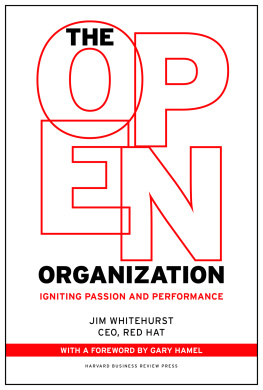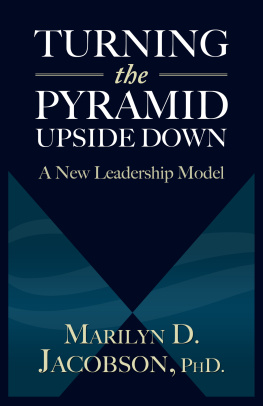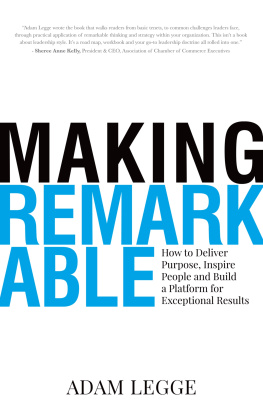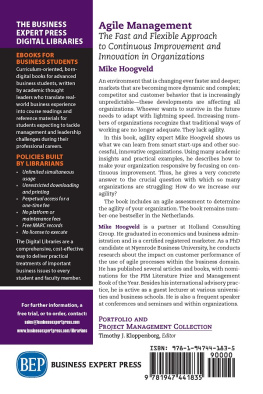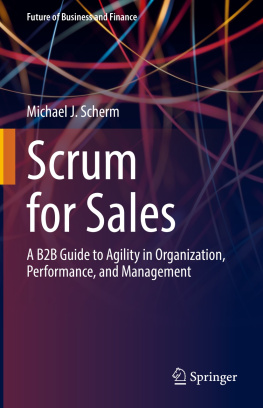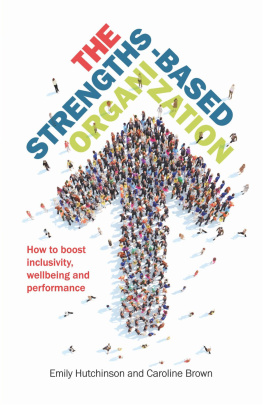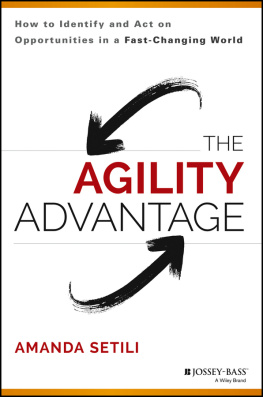We live in an increasingly open world, and in The Open Organization: Igniting Passion and Performance , Jim Whitehurst uses his experience in open source technology as a blueprint for leadership. Jim clearly demonstrates how building avidly engaged communities of employees, partners, and customers can ignite the kind of passion and innovation that drive outsized results for businesses and for society as a whole. This is a great read for anyone hoping to lead and succeed in a society being redefined by expectations of transparency, authenticity, accessand yes, in a word, openness.
MICHAEL DELL, Chairman and CEO, Dell
In a wired world, everyone knows that management needs to change from command and control to leadership based on transparency, collaboration, and participation. But the question is, how do you actually lead that way? How does a leader give up so much power for something that looks like chaos? How do you get the leap in performance that comes from unleashing peoples passion and creativity? Jim Whitehursts interesting tale of his own reinvention as a leader, with lessons from other leaders in companies such as Whole Foods, Pixar, Zappos, and others, finally provides the blueprint that leaders have been seeking.
CHRIS ANDERSON, cofounder and CEO, 3D Robotics; former Editor in Chief, Wired magazine
Many people are wary of change. If its out of ones control, highly visible, and potentially volatile, it has the makings of a nightmare. For executives who worry about Millennial employees and the power of the internet, it is scary indeed. Yet those same employees could offer valuable new perspectives, ideas, and passion. The question is, how do todays managers capture those desirable attributes without setting off the perfect storm? The answers are in Jim Whitehursts book The Open Organization: Igniting Passion and Performance .
JEANIE DANIEL DUCK, former Senior Partner and Managing Director, The Boston Consulting Group; author, The Change Monster
In todays disruptive economy, only the leadersand their organizationswho are open and learn to adapt to the fast-changing needs of customers and employees will survive. Whitehurst speaks from personal experience about what worksand what doesntto foster openness and speed. If you have even an inkling of a desire to lead an innovative, fast-moving, and engaged organization, this book is for you.
CHARLENE LI, founder and CEO, Altimeter Group; author, The Engaged Leader and Open Leadership
Drawing from the lessons hes learned leading an organization born directly from the principles of open source, Jim Whitehurst offers us an invaluable guide to success for the modern organization based on true openness, collaboration, and shared commitment. With The Open Organization , Whitehurst takes us where all leaders need to be if we want to succeed in the futureoutside of our traditional comfort zones.
JOHN CHAMBERS, Chairman and CEO, Cisco


IGNITING PASSION AND PERFORMANCE
JIM WHITEHURST
CEO, RED HAT
with a Foreword by GARY HAMEL
HARVARD BUSINESS REVIEW PRESS
BOSTON, MASSACHUSETTS
HBR Press Quantity Sales Discounts Harvard Business Review Press titles are available at significant quantity discounts when purchased in bulk for client gifts, sales promotions, and premiums. Special editions, including books with corporate logos, customized covers, and letters from the company or CEO printed in the front matter, as well as excerpts of existing books, can also be created in large quantities for special needs. For details and discount information for both print and
ebook formats, contact ,
tel. 800-988-0886, or www.hbr.org/bulksales .
Copyright 2015 Red Hat, Inc.
All rights reserved
No part of this publication may be reproduced, stored in or introduced into a retrieval system, or transmitted, in any form, or by any means (electronic, mechanical, photocopying, recording, or otherwise), without the prior permission of the publisher. Requests for permission should be directed to , or mailed to Permissions, Harvard Business School Publishing, 60 Harvard Way, Boston, Massachusetts 02163.
The web addresses referenced in this book were live and correct at the time of the books publication but may be subject to change.
Library of Congress Cataloging-in-Publication Data
Whitehurst, Jim.
The open organization : igniting passion and performance / Jim Whitehurst.
pages cm
ISBN 978-1-62527-527-1 (hardback)
1. Organizational effectiveness. 2. Organizational behavior. 3. Organizational change. 4. Employee motivation. 5. ManagementEmployee participation. 6. Decentralization in management. I. Title.
HD58.9.W526 2015
658.3152dc23
2014045002
This book is dedicated to the millions of
open source contributors and users out there
who make what we do possible.
CONTENTS
FOREWORD
Heres a conundrum. The human capabilities that are most critical to successthe ones that can help your organization become more resilient, more creative, and more, well, awesomeare precisely the ones that cant be managed. While you can compel financially dependent employees to be obedient and diligent, and can recruit the most intellectually capable, you cant command initiative, creativity, or passion. These human capabilities are, quite literally, gifts. Every day employees choose whether to bring them to work or leave them at home. Suppliers and customers make similar decisionsto engage with your enterprise in a spirit of true collaboration or apply their energies elsewhere. As a leader, how do you create an environment that inspires people to volunteer those gifts?
Nearly fifty years ago, Warren Bennis, the much-missed leadership guru, predicted that wed soon be working in organic-adaptive structures, organizations that feel like communities, not hierarchies. In a community, the basis for loyalty is a common purpose, not economic dependency. Control comes from shared norms and aspirations, not from policies and bosses. Rewards are mostly intrinsic rather than extrinsic. Contributions arent predetermined and individuals are free to contribute as they may. Examples are as diverse as a meeting of Alcoholics Anonymous or a team erecting a house for Habitat for Humanity.
Bennis had a compelling vision, but until recently it was hard to believe that community-centric structures could ever scale. Then came the internet. The defining characteristic of the internet is its openness. Online, human beings are free to connect, contribute, and create as never before, and billions of them have exploited that opportunity. Consider YouTube. Every minute, more than a hundred hours of content are posted to YouTube, and each month, more than 6 billion hours of video are consumed by viewers from around the world. YouTube is open; anyone can contribute, and at present, more than a million contributors make money from content theyve uploaded to the site.
Im old enough to remember when networks were closed. Thirty years ago, if you wanted to add another telephone to your home, you leased it from the network operatorbe it AT&T, BT, Bell Canada, or any other telco. Moreover, your phone was a dumb device. All the intelligence resided in the giant computers that routed your calls. To add a new service, like call-waiting, the operator had to reprogram the central switch, an expensive and risky endeavor. Screw it up and you could bring down the whole network. Not surprisingly, innovation proceeded at a snails pace. Today, the web hosts hundreds of web-based communication services including Apples iMessage, WhatsApp, Snapchat, Kakao Talk, Google Hangout, WeChat, and Grasshopper. On Skype alone, users spend more than 2 billion minutes communicating each day.
Next page
